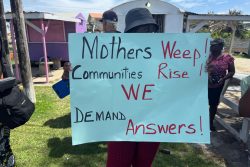Another mother is accusing the Georgetown Public Hospital of negligence after her 12 pound infant died during delivery and the hospital refused her request for an autopsy and buried the baby against her wishes.
Primary School teacher Pamela Lashley, 32, of Victoria, East Coast Demerara, told Stabroek News that she was forced to deliver her infant son vaginally on Friday morning. The woman said that she is convinced her baby died of a broken neck he suffered after his head protruded before she was taken to the delivery room. It is the second such case reported at the hospital ion the last week.
This newspaper visited the visibly-weak woman yesterday at her home, where she recounted her labour, which began on Friday around 3am. She arrived at the hospital some three hours later.
“This is my fourth child so I know the routine… I went and told the nurse I’m in labour and she examined me and told me I’m not quite ready,” she said. Lashley said she waited for about an hour and half before another nurse attended to her and explained that the baby was bigger than usual and that she was going into early labour. The baby up to this point had a steady heart rate, she added.
When she met with the doctor, Lashley was told that it could not be ascertained if the baby was indeed very big, so an ultrasound was suggested. “They took me to the antenatal ward and the doctor came and ruptured the water bag and inserted Cytotec and said he did it to induce labour… They put a needle in my hands with drips and put me on the bed. I was 6 centimetres at that time,” she recalled.
The devastated woman said that within ten minutes, she could have naturally felt her child’s head bearing downwards and she immediately indicated this to the nurses, who doubted her. “I say ‘nurse is time’ and she say ‘Lashley is not time. You can’t dilate to10 centimetres so fast’ and they keep saying you ain’t ready yet and the baby head start coming out right there,” Lashley said.
She explained that a visitor in the ward had to assist her off the bed. “Even when the nurse come with the wheelchair, she saying, ‘Lashley sit down properly, brace your back properly.’ But I couldn’t, because I could feel my baby, I had to raise myself up,” she stated.
She was rushed to the labour room, where was immediately instructed to start pushing after the doctor declared that the baby had to be delivered as soon as possible.
“When he come out, I raise up to see him and the nurse put something on his chest and was like he dead. I say, ‘Nurse, wa happen? Baby dead?’ And she shake she head. I pick him up and hold him and put him to my breast and she come to take him away and say we have to weigh this baby and then she ask if I burying the baby and I said yes,” she recalled.
Cause of death
Lashley said her son was “healthy and nice, a baby any mother would want to hold.” Later, she said the nurses blamed the negligence of the Lusignan Health Centre, where she went for her check ups. “They say the midwife was supposed to send me to get this baby by 34 weeks because it’s a huge baby,” she noted, adding that she was 40 weeks pregnant at the time of the delivery.
“To my knowledge, the baby neck break because even though he was so soft, around his head had a red line and his eyelids had bloodshot. My baby died between the time I left the antenatal ward to the labour room,” she maintained.
Lashley further said that after doctors could not provide her with a cause of death, she insisted that an autopsy be performed but was told that it was not necessary. “I told the doctor you said you don’t know why the baby died and I want to know why the baby died and he said there are so many reasons… He went back to the health centre and I ask him why he didn’t let me do a caesarean and he said because my records show that I always have a normal delivery,” she relayed.
No permission
for burial
The following day, Lashley said doctors approached her with forms to leave the baby and to have the state bury the child. However, she refused to sign the documents, insisting that she must bury her baby. Nevertheless, the grieving woman said when she subsequently returned to the hospital to collect her baby’s body; she was told that a burial was already done.
“I asked where they bury my child and they said they don’t do gravestones so they won’t know where and is more than one baby bury. I went back again because I still don’t believe that they would just do that, that they would go ahead and bury the child and I did not give permission but is the same thing they say,” she expressed.
A week ago, a similar case occurred at the GPH when another 12 pound baby was delivered by caesarean to 39-year-old Vonette Husler. After three days in labour, Husler delivered the baby boy but when she asked for her child, she was told by authorities that he had developed respiratory troubles during delivery as he possibly had ingested fluids, which were in his lungs. The infant subsequently died, she was told.
Only recently, the hospital rejected claims that it was in any way responsible for the deaths of two infants who had succumbed shortly after their mothers had also died during delivery.
Samantha Bruce, 17, of Soesdyke, recently died at the Georgetown Public Hospital after delivering twins, one boy and a girl. The female infant subsequently passed away, while undergoing care, while the male child remains in the Intensive Care Unit.
The other young mother, Chitrawattie Ramjiwan, 20, of Cotton Tree, West Coast Berbice died while being transferred from Fort Wellington Hospital to the New Amsterdam Hospital. She had delivered a girl and had developed complications. The child was rushed to the GPH and was being monitored, but she, too, died a few days after. While an autopsy was not performed on the infant, the one done on her mother listed her cause of death as haemorrhaging and hemorrhagic shock. Two obstetricians later stated that the monitoring of the babies after birth in both cases was lax.
The Ministry of Health has also come in for sharp criticism since at of May 31st there had already been nine reported maternal deaths for the year, despite more training of healthcare officials in the area of neonatal care.









